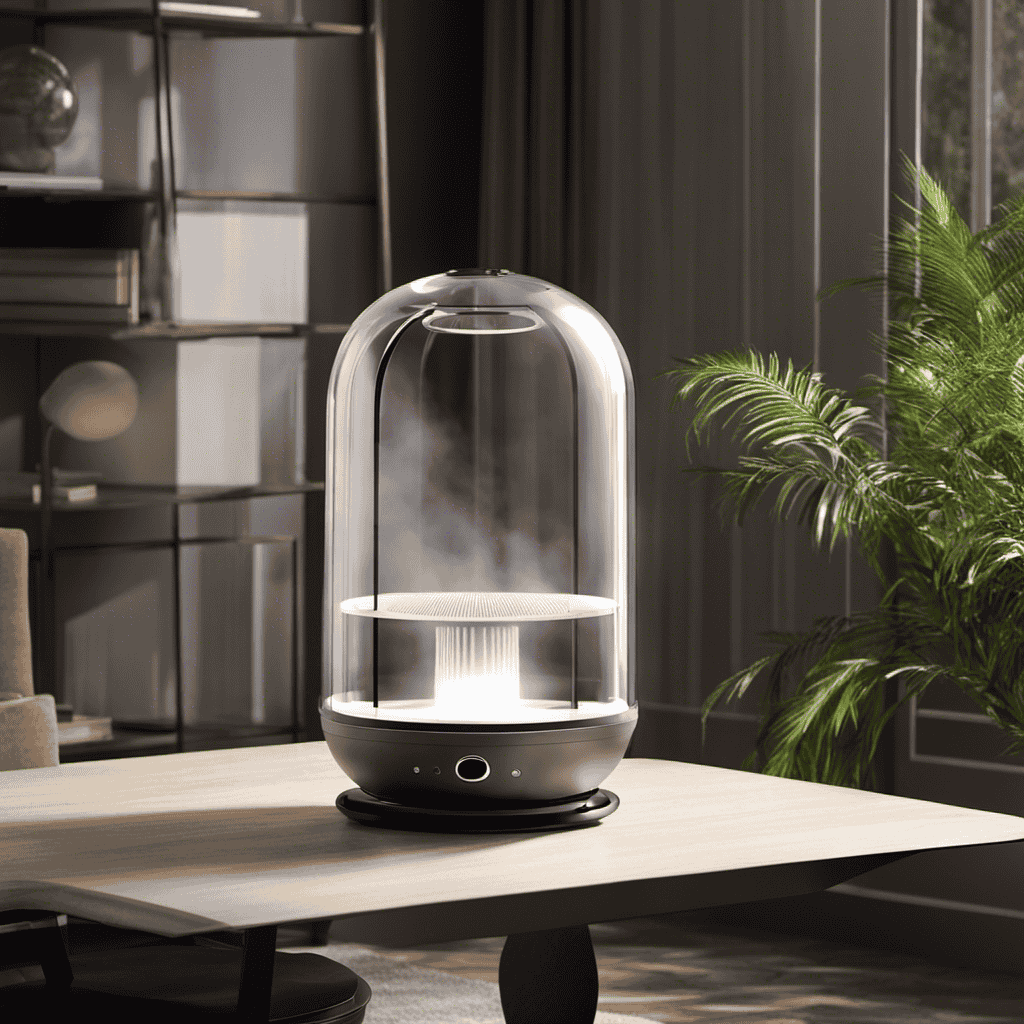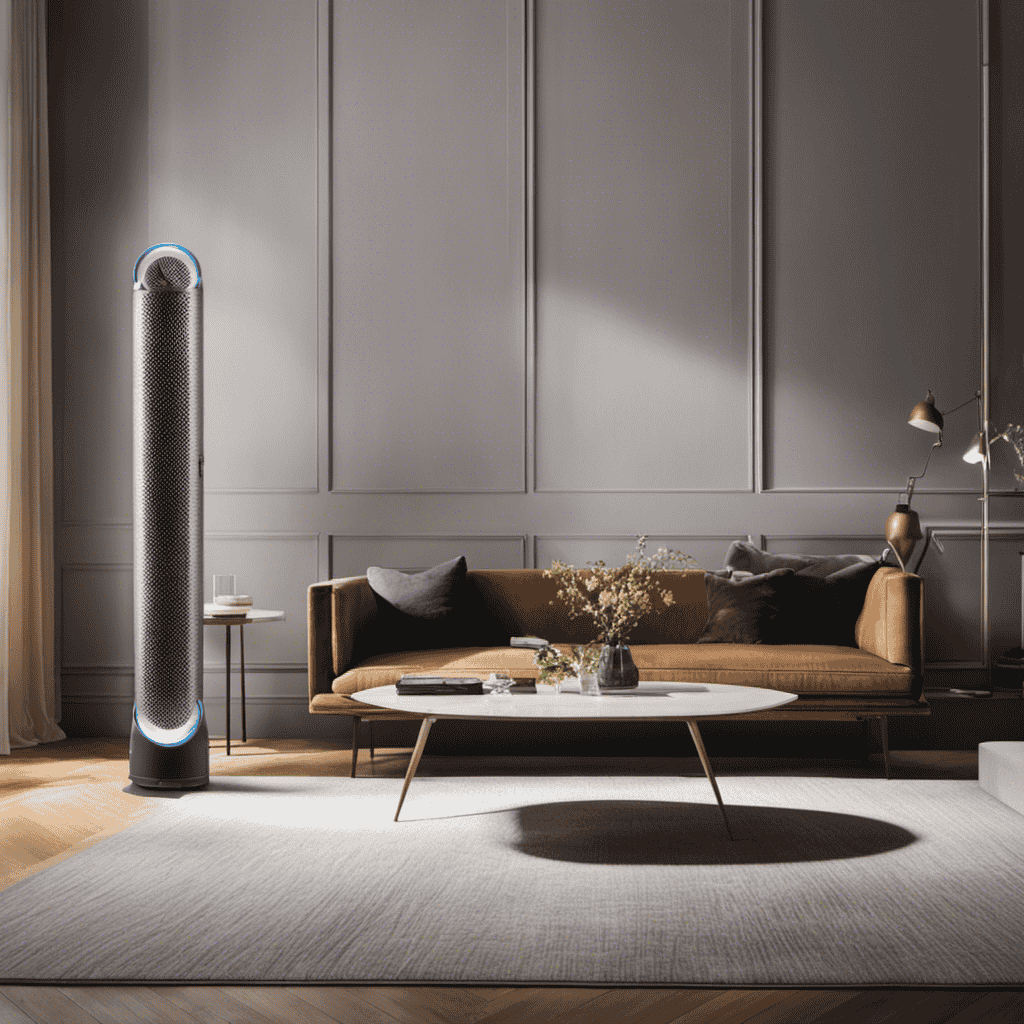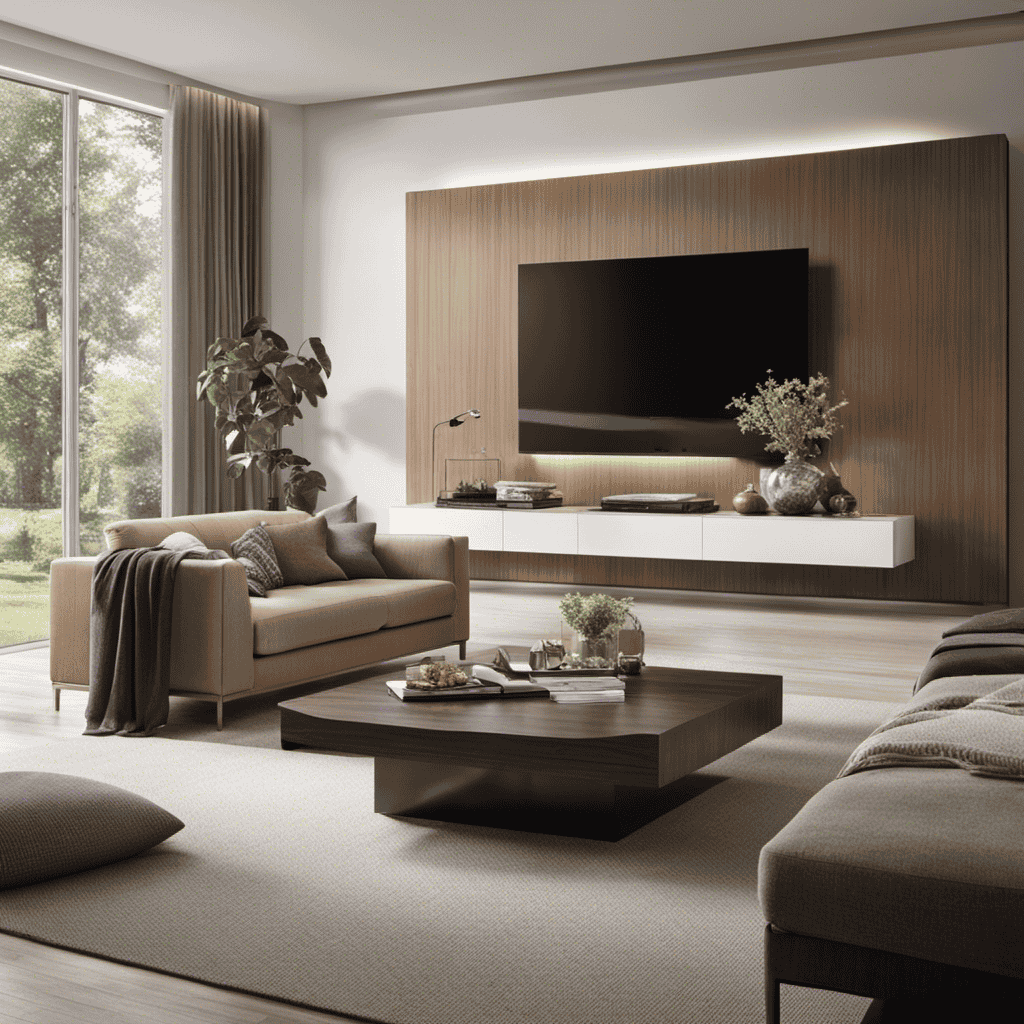Are you curious about the impact of VOCs on indoor air quality? If so, you’ve come to the right location!
In this article, I will provide you with all the information you need to understand VOCs and their connection to air purifiers. We will explore the basics of VOCs, their sources, and the potential health effects they can have.
Additionally, we will discuss how air purifiers work to remove VOCs and guide you in choosing the right one for your needs.
So, let’s dive in and discover the world of VOCs in air purifiers!
Key Takeaways
- VOCs are harmful gases emitted by various sources and can cause respiratory problems, eye irritation, and even cancer.
- Using an air purifier with activated carbon filters can significantly reduce exposure to VOCs and improve indoor air quality.
- Regular calibration of VOC sensors is essential for accurate measurements and reliable air quality assessment.
- Minimizing exposure to VOCs is crucial for protecting respiratory health, cognitive function, and reproductive health.
The Basics of VOCs
VOCs, or volatile organic compounds, are harmful gases emitted by various sources, such as cleaning products and paints. Understanding VOC chemistry is essential to comprehending their environmental impact.
VOCs are carbon-based chemicals that easily vaporize at room temperature. They are released into the air through evaporation or combustion processes. Once in the atmosphere, VOCs can react with other pollutants, contributing to the formation of harmful smog and ground-level ozone.
These compounds can have adverse effects on human health, causing respiratory problems, eye irritation, and even cancer. Additionally, VOCs can also harm the environment by contributing to air pollution and damaging ecosystems.
Therefore, it is crucial to find ways to reduce VOC emissions and improve air quality.
Transitioning into the subsequent section, we will now explore understanding VOC sources.
Understanding VOC Sources
To better understand where VOCs come from, you should consider common household products such as cleaning supplies and furniture. VOCs, or volatile organic compounds, are chemicals that can be emitted as gases from certain solids or liquids. They are found in a variety of products used in and around the home, including paints, varnishes, adhesives, solvents, and even air fresheners. These VOCs can have both short-term and long-term health effects, depending on the specific compound and the level of exposure. Identifying VOCs can be challenging as they can come from multiple sources. To help you visualize some common VOC emission sources, here is a table showcasing a few examples:
| VOC Emission Source | Examples |
|---|---|
| Cleaning Supplies | Bleach, disinfectants |
| Furniture | Upholstery, pressed wood |
| Paints and Varnishes | Oil-based paints, lacquers |
Understanding the sources of VOCs is crucial for managing and reducing their presence in indoor air.
Health Effects of VOCs
When it comes to our respiratory health, VOCs can pose a significant risk. These volatile organic compounds can irritate the respiratory system and lead to symptoms such as coughing, wheezing, and shortness of breath.
In the long term, exposure to VOCs has been associated with more serious health risks, including an increased risk of developing respiratory conditions such as asthma and even certain types of cancer.
To reduce our exposure to VOCs, it is important to be mindful of the products we use and choose low VOC alternatives whenever possible. It is also important to ensure proper ventilation in our homes and workplaces.
Vocs and Respiratory Health
You can improve your respiratory health by reducing exposure to volatile organic compounds (VOCs) in the air. VOCs are chemicals that can be found in various products, such as paint, cleaning supplies, and furniture. These compounds can be released into the air, leading to indoor air pollution.
Long-term exposure to VOCs has been associated with respiratory problems, including asthma and allergies. It is particularly important to minimize VOC exposure in children, as their developing respiratory systems are more vulnerable.
To prevent VOC exposure, you can take several measures. These include using low-VOC or VOC-free products, ensuring proper ventilation in your home, and regularly cleaning and dusting to remove VOC particles.
Long-Term Health Risks
Reduced exposure to VOCs can lead to improved long-term respiratory health. Long-term exposure to volatile organic compounds (VOCs) has been linked to a range of health risks, including respiratory issues such as asthma, allergies, and even lung cancer. Prevention measures are crucial in minimizing the long-term effects of VOC exposure.
Here are two sub-lists that highlight the emotional impact of these risks:
-
Physical well-being:
-
Long-term exposure to VOCs can cause chronic respiratory problems, leading to difficulty in breathing and reduced quality of life.
-
The fear of developing serious illnesses like lung cancer due to VOC exposure can cause anxiety and stress.
-
Environmental concerns:
-
The knowledge that VOCs contribute to air pollution and climate change can evoke feelings of guilt and helplessness.
-
The impact of VOCs on indoor air quality can lead to concerns about the well-being of loved ones, especially children and the elderly.
To protect ourselves and future generations, it is essential to take proactive measures in reducing our exposure to VOCs. By implementing proper ventilation, using low VOC products, and utilizing air purifiers that effectively filter VOCs, we can significantly minimize the long-term health risks associated with these harmful compounds.
Reducing Exposure to Vocs
In order to reduce exposure to VOCs (Volatile Organic Compounds), it is important to take proactive measures to improve indoor air quality.
One effective method is to use an air purifier. Air purifiers are designed to remove harmful pollutants, including VOCs, from the air we breathe. They work by pulling in the surrounding air and passing it through a series of filters that capture and trap these contaminants.
By using an air purifier, you can significantly reduce your exposure to VOCs, which can have long-term health risks. The benefits of using an air purifier extend beyond VOC reduction, as they also help to remove other harmful particles such as dust, pollen, and pet dander.
Transitioning to the subsequent section about VOCs and indoor air quality, let’s explore the impact of VOCs on our indoor environment.
VOCs and Indoor Air Quality
When it comes to VOCs and indoor air quality, it’s important to understand the impact they can have on your health.
VOCs, or volatile organic compounds, are chemicals that can be released into the air from various sources such as paints, cleaning products, and furniture. These compounds can contribute to indoor air pollution and have been linked to a range of health effects, including respiratory issues, headaches, and allergies.
To assess the level of VOCs in indoor air, various testing methods are used, such as gas chromatography and mass spectrometry. It is crucial to monitor and control VOC levels in indoor environments to ensure a healthy living space.
Common VOCs Found in Homes
In the previous subtopic, we discussed VOCs and their impact on indoor air quality.
Now, let’s delve into the common VOCs found in homes and their harmful effects.
Common VOCs include formaldehyde, benzene, toluene, and xylene, which can be emitted from various sources such as cleaning products, paints, adhesives, and even furniture.
These VOCs have been linked to numerous health issues, including respiratory irritation, headaches, dizziness, and in some cases, even cancer.
Prolonged exposure to high levels of VOCs can significantly affect our well-being, especially for vulnerable individuals like children, the elderly, and those with respiratory conditions.
Therefore, it is crucial to be aware of the presence of these common VOCs in our homes and take steps to minimize their release or remove them from our indoor environment.
Detecting and Measuring VOC Levels
In this discussion, I’ll explore the accuracy of VOC sensors and the importance of calibrating VOC measurements. I’ll also touch on the potential health effects of VOCs.
VOC sensors are crucial in detecting and measuring volatile organic compounds in the air. However, their accuracy can vary due to factors like sensor technology and environmental conditions.
To ensure reliable measurements, regular calibration of VOC sensors is essential. This helps maintain their accuracy and ensures that the readings are trustworthy.
Understanding the health effects of VOCs is also crucial. Exposure to high levels of these compounds can lead to various respiratory and neurological issues. It’s important to be aware of these potential risks and take necessary precautions to minimize exposure.
Accuracy of VOC Sensors
You can’t rely solely on VOC sensors to accurately measure air quality. While VOC sensor technology has advanced over the years, there are still limitations to consider. Here are a few reasons why VOC sensors may not provide a complete picture of air quality:
-
Sensitivity: VOC sensors may not detect all types of volatile organic compounds, leading to potential false readings.
-
Calibration: Proper calibration is essential for accurate measurements, but it can be challenging to maintain consistently.
-
Interference: Other factors in the environment, such as humidity or temperature, can affect the performance of VOC sensors.
-
Lack of Standardization: There is currently no universally accepted standard for VOC sensor calibration, leading to inconsistencies in measurements and comparisons.
Considering these limitations, it’s important to use VOC sensors as one tool among others to assess air quality accurately.
Calibrating VOC Measurement
To accurately calibrate VOC measurements, it’s crucial to follow the manufacturer’s guidelines and regularly check for any deviations in readings. Calibrating VOC sensors ensures the accuracy and reliability of the measurements. Calibration involves adjusting the sensor to match a known reference or standard.
This process is necessary because VOC sensors can drift over time, leading to inaccurate readings. The calibration process typically involves exposing the sensor to a known concentration of VOCs and comparing the measured response to the expected value. This allows for adjustments to be made to the sensor’s settings, ensuring accurate measurements.
Various techniques can be used for calibrating VOC sensors, including dynamic spiking, where the sensor is exposed to a series of known VOC concentrations, and zeroing, where the sensor is exposed to pure air to establish a baseline reading.
Regular calibration is essential for maintaining the accuracy and reliability of VOC measurements.
Health Effects of Vocs
Now that we understand how VOCs are measured in air purifiers, let’s delve into the health effects of these volatile organic compounds.
Exposure to VOCs can have various impacts on our well-being. When it comes to cognitive function, research has shown that long-term exposure to high levels of VOCs can lead to decreased cognitive performance, memory problems, and impaired concentration. This is particularly concerning for individuals who are exposed to VOCs in their workplaces or homes for extended periods.
In addition to cognitive function, VOCs can also have adverse effects on reproductive health. Studies have suggested a link between VOC exposure and fertility issues, including reduced sperm quality and hormonal imbalances in both men and women. Pregnant women exposed to high levels of VOCs may also be at risk of complications such as preterm birth or developmental abnormalities in their children.
It is crucial to minimize our exposure to VOCs to protect our cognitive function and reproductive health.
How Air Purifiers Remove VOCs
One way air purifiers can remove VOCs is by using activated carbon filters. These filters are designed to absorb and trap volatile organic compounds, or VOCs, from the air. VOCs are chemicals that can be found in common household products such as cleaning agents, paints, and furniture. When these chemicals are released into the air, they can contribute to poor indoor air quality and potential health risks.
Activated carbon filters work by utilizing the process of adsorption, where the carbon material attracts and binds the VOC molecules. This technology has been shown to be effective in reducing VOC levels in indoor environments, improving the air quality and creating a healthier living space.
Air purifiers with activated carbon filters are recommended for individuals who are concerned about the presence of VOCs in their homes or workplaces.
Choosing the Right Air Purifier for VOCs
Using activated carbon filters is an effective way to reduce VOC levels and improve indoor air quality. When choosing an air purifier for VOCs, it is important to consider the following features:
-
High-quality activated carbon filters: These filters are specifically designed to trap and remove VOCs from the air, helping to reduce their concentration.
-
Multiple filtration stages: Look for air purifiers that have multiple filtration stages, including a dedicated stage for VOC filtration. This ensures thorough removal of VOCs from the air.
When considering the benefits of VOC filtration, it is important to note that it can significantly improve indoor air quality by reducing the presence of harmful chemicals. This can lead to numerous health benefits, including:
-
Reduced risk of respiratory issues: VOCs can irritate the respiratory system and cause or worsen respiratory conditions such as asthma. By removing VOCs from the air, air purifiers can help alleviate these symptoms.
-
Enhanced overall well-being: Breathing in clean air free from VOCs can contribute to a sense of well-being and improve overall quality of life.
Frequently Asked Questions
Are All Vocs Harmful to Human Health?
Not all VOCs are harmful to human health, but some can pose potential health risks. The regulation of VOCs is important to ensure that the levels in the air are safe for breathing.
What Are Some Common Symptoms of Exposure to Vocs?
Some common symptoms of exposure to VOCs include headaches, dizziness, and respiratory irritation. To detect VOCs in indoor air, you can use air quality monitors or conduct laboratory tests. Long term exposure to VOCs can have detrimental effects on our health.
Can Vocs Be Present in Outdoor Air?
Yes, VOCs can be present in outdoor air. They are released from various sources such as vehicle emissions, industrial processes, and chemicals. Outdoor air pollution can contribute to the presence of VOCs in the environment.
How Long Do Vocs Typically Stay in the Air?
Typically, VOCs can stay in the air for varying periods depending on factors like temperature, ventilation, and the specific chemicals involved. Testing indoor air for VOC levels can help assess their impact on indoor air quality.
Are There Any Natural Ways to Reduce VOC Levels in Indoor Spaces?
There are natural ways to reduce VOC levels in indoor spaces, such as using plant-based air purifiers. These purifiers can effectively filter out harmful chemicals and improve the air quality in your home.
Conclusion
In conclusion, VOCs (volatile organic compounds) are harmful chemicals that can negatively impact indoor air quality and human health. They are commonly found in everyday household items such as cleaning products, paints, and furniture.
Using an air purifier specifically designed to remove VOCs can help improve the air quality in your home. By eliminating these harmful compounds, you can create a healthier living environment for you and your family.
So, why wait? Take a breath of fresh air and invest in an air purifier today. Trust me, your lungs will thank you.









